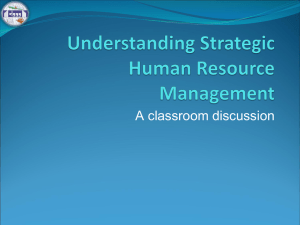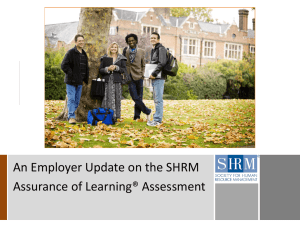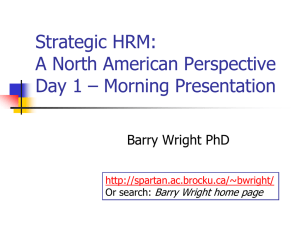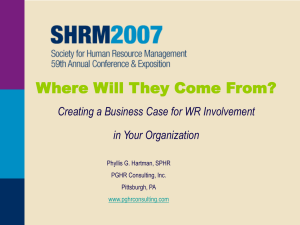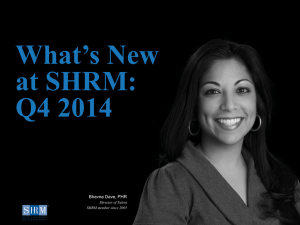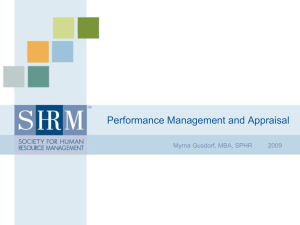The Future of the U.S. Workforce Series
advertisement
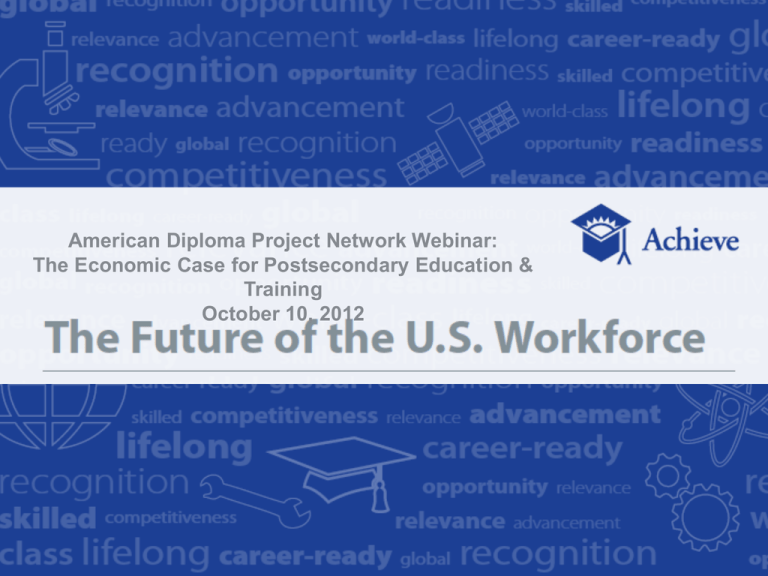
American Diploma Project Network Webinar: The Economic Case for Postsecondary Education & Training October 10, 2012 The Future of the U.S. Workforce Common Core State Standards & Career and Technical Education: Bridging the Divide between College and Career Readiness The Future of the U.S. Workforce: Middle Skills Jobs and the Growing Importance of Postsecondary Education The Future of the U.S. Workforce: The Limited Career Prospects for High School Graduates Without Additional Education and Training The Future of the U.S. Workforce: A Survey of Hiring Practices Across Industries www.achieve.org/career-readiness The Future of the U.S. Workforce: Middle Skills Jobs and the Growing Importance of Postsecondary Education Commissioned research to: Summarize and synthesize that research to help policymakers and advocates understand the research base and its connection to college- and career-ready reforms. The report: Lays out the various definitions/constructs of “middle skills” Provides information on current and future employee demands, including state- and industry-specific information Explores the pervasiveness of the “skills mismatch” Describes the various pathways to middle skills jobs Makes the connection between middle skills jobs and access to the middle class Offers recommendations to address middle skills jobs demand The Future of the U.S. Workforce: The Limited Career Prospects for High School Graduates Without Additional Education and Training Commissioned new, original research to answer the question: What are the career prospects for individuals with only a high school diploma or less? Is education beyond high school really necessary to ensure a middle class lifestyle, a good living wage and career advancement opportunities? There are a good proportion of jobs that require only a high school diploma or less, BUT They typically pay less; Offer fewer opportunities for advancement and leadership; and Require far fewer skills than middle skills jobs, suggesting individuals really do need additional education/ training across skills areas to advance. The Future of the U.S. Workforce: A Survey of Hiring Practices Across Industries Commissioned new, original research with SHRM to answer the question: What is the impact of the “skills mismatch” on hiring practices? The survey found: Every industry was hiring in 2011, with over 95% of respondents saying they had open positions in 2011. All industries are projecting that future jobs will require more skills, education and credentials at all levels. Opportunities do still exist for low skills workers, but there is reason to suspect these opportunities will shrink in the future. SHRM Survey Findings: Changing Employee Skills and Education Requirements In collaboration with and commissioned by Achieve October 3, 2012 Methodology • The following nine industries were included in the sample. Construction, mining, oil and gas Federal government Finance Health High-tech Manufacturing Professional services State and local government Nonprofessional services SHRM/Achieve Survey: Changing Employee Skills and Education Requirements—Minimum Education Requirements ©SHRM 2012 7 SHRM Survey Findings: Changing Employee Skills and Education Requirements In collaboration with and commissioned by Achieve Survey Methodology • Response rate = 18% • 4,695 HR professional respondents from a randomly selected sample of nine different industries in SHRM’s membership Construction, mining, oil and gas = 491 Federal government = 356 Finance = 530 Health = 526 High-tech = 447 Manufacturing = 526 Professional services = 492 State and local government = 848 Non-professional services = 479 • Margin of error +/-1% • Survey fielded March 28-April 30, 2012 SHRM/Achieve Survey: Changing Employee Skills and Education Requirements—Minimum Education Requirements ©SHRM 2012 8 Skills shortages and recruiting difficulty • SHRM research has recently shown that despite weak economic conditions our members are reporting: • Skills shortages in many industries (Ongoing Impact of the Recession Survey series) and • Recruiting difficulty (monthly LINE survey) SHRM/Achieve Survey: Changing Employee Skills and Education Requirements—Minimum Education Requirements ©SHRM 2012 9 Key Findings • A few industries do still offer a few jobs with no minimum education requirements: nonprofessional services (21%), construction, mining, oil and gas (19%), and manufacturing (12%). However, in all other industries, fewer than 10% of job openings in 2011 had no minimum educational requirements (see slide 15). • Even lower-skilled jobs are likely to have minimum education requirements, with 71% of organizations forecasting a requirement for a high school diploma and 7% expecting a specific post-secondary certificate/credential or an associate’s degree for such jobs. • Organizations across all industries are projecting that future jobs at all levels will require more skills, education and credentials/certifications. • Only a small percentage of organizations’ training budgets are dedicated to remedial education (a median of 1% and a mean of 7% across industries and organization sizes). The majority (81%) of employees are trained on-site, followed by employer-provided off-site training (57%) and technical or community colleges (44%). • Organizations across industries are most likely to report an increased need for bachelor’s degree holders (55%), advance degree holders (41%) and specific postsecondary certificates/credentials (32%). • Organizations in most industries project future education requirements for salaried individual contributors and professional jobs to level off at the bachelor’s degree level (71%), with only 5% forecasting requirements for advanced degrees for these types of jobs. The federal government is slightly more likely than other industries to project a need for advanced degrees in these jobs (13%). SHRM/Achieve Survey: Changing Employee Skills and Education Requirements—Minimum Education Requirements ©SHRM 2012 10 Further study • SHRM benefits research shows a trend away from educational reimbursement. How will this impact educational attainment of workers? • Most training is done in-house currently. Will this change as skills and education needs rise? • Overall what are HR professionals and businesses doing to deal with skills shortages in their communities? What is working? SHRM/Achieve Survey: Changing Employee Skills and Education Requirements—Education Levels of Today’s Workforce ©SHRM 2012 11 SHRM Survey Findings: Changing Employee Skills and Education Requirements About SHRM Research • For more survey/poll findings, visit www.shrm.org/surveys • For more information about SHRM’s Customized Research Services, visit www.shrm.org/customizedresearch • Follow us on Twitter @SHRM_Research SHRM/Achieve Survey: Changing Employee Skills and Education Requirements—Minimum Education Requirements ©SHRM 2012 12 SHRM Survey Findings: Changing Employee Skills and Education Requirements—Post-secondary Certificates/Credentials Demographics SHRM/Achieve Survey: Changing Employee Skills and Education Requirements—Post-secondary Certificates/Credentials and Demographics ©SHRM 2012 13 Demographics: Organization Industry n = 4,642 SHRM/Achieve Survey: Changing Employee Skills and Education Requirements—Post-secondary Certificates/Credentials and Demographics ©SHRM 2012 14 Demographics: Organization Sector n = 3,439 SHRM/Achieve Survey: Changing Employee Skills and Education Requirements—Post-secondary Certificates/Credentials and Demographics ©SHRM 2012 15 Demographics: Organization Staff Size Note: n = 3,335. Percentages do not total 100% due to rounding. SHRM/Achieve Survey: Changing Employee Skills and Education Requirements—Post-secondary Certificates/Credentials and Demographics ©SHRM 2012 16 Demographics: Other Does your organization have U.S.-based operations (business units) only or does it operate multinationally? Is your organization a single-unit organization or a multiunit organization? U.S.-based operations only 75% Single-unit organization: An organization in which the location and the organization are one and the same Multinational operations 25% Multi-unit organization: An organization that has more than one location 70% n = 3,451 n = 3,446 What is the HR department/function you responded for throughout this survey? Corporate (company wide) 69% Business unit/division 17% Facility/location 14% n = 2,465 30% For multi-unit organizations, are HR policies and practices determined by the multi-unit headquarters, by each work location or both? Multi-unit headquarters determines HR policies and practices 53% Each work location determines HR policies and practices 2% A combination of both the work location and the multi-unit headquarters determine HR policies and practices 44% Note: n = 2,460. Percentages do not total 100% due to rounding. SHRM/Achieve Survey: Changing Employee Skills and Education Requirements—Post-secondary Certificates/Credentials and Demographics ©SHRM 2012 17 The Future of the U.S. Workforce: Middle Skills Jobs and the Growing Importance of Postsecondary Education The Future of the U.S. Workforce: The Limited Career Prospects for High School Graduates Without Additional Education and Training 18 Jobs by Skill Level High skills--at least a bachelor’s degree, considerable skill and preparation Middle skills--more education and training than a high school diploma, not a bachelor’s degree Low skills--no more than a high school diploma Methodology Literature review with a focus on middle skills jobs Analysis with a focus on low skills jobs using data from Occupational Information Network (O*NET) Bureau of Labor Statistics wage data About O*NET Information on over 900 occupations including: skills and education requirements tasks and work activities work context work styles related occupation wages and employment occupational outlook Based on questionnaires and data from other agencies Analysis used largely wage (incorporating BLS data), potential for advancement, and job recognition/prestige information Findings Jobs requiring education beyond high school will make up the largest proportion of available jobs, but according to current projections, there will be a shortage in the number of workers need to fill those jobs. Workers holding jobs that require no more than a high school diploma (low skills jobs) have lower earnings potential, career advancement potential, and prestige. Significant skill requirement gap between low and middle skills occupations, and workers in low skills occupations not likely to be exposed to clear pathways to bridge those gaps and earn those skills. Questions that Remain to be Answered What are the characteristics of individuals in low skills occupations? Are these jobs supplemental or primary? What are the factors that lead to an individual staying in a low skills occupation? How can pathways be opened to help individuals be promoted to middle and high skills occupations? What are the most effective programs and pathways for advancing out of low skills occupations? What are the most effective ways of ensuring that the demand for middle skills workers will be met? Questions? All three reports can be found at: www.achieve.org/career-readiness For more information, contact: Kate Blosveren (kblosveren@achieve.org) Jennifer Schramm (Jennifer.Schramm@shrm.org) Alli Bell (allison.catelyn@gmail.com) 24 American Diploma Project Network Webinar: The Economic Case for Postsecondary Education & Training October 10, 2012
